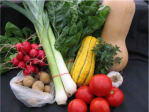 It has been a wonderful Christmas season here in North Georgia. While many parts of the country are suffering under the weight of major winter storms and frigid winds, we have enjoyed unusually pleasant conditions. In fact, it was 73 degrees on Christmas day. Today is the 28th and it’s still gorgeous.
It has been a wonderful Christmas season here in North Georgia. While many parts of the country are suffering under the weight of major winter storms and frigid winds, we have enjoyed unusually pleasant conditions. In fact, it was 73 degrees on Christmas day. Today is the 28th and it’s still gorgeous.
After terrible drought that lasted from late spring, we’ve had plenty of rain in December and with the recent warm up, our pastures and lawns are showing signs of life again. It’s such a blessing.
There are many things I love about this time of year, including: eggnog, carols, colored lights, Emmanuel, decking the halls, and getting the mail. Each afternoon I rush to the mailbox in eager anticipation of what the postman has delivered. And most days, among the Christmas cards, seasonal flyers, and bills, is at least one or more catalogs from seed companies around the country. I cherish each one of them, and devour them like a hungry man devours a bologna sandwich.
You see, it’s garden planning season. It’s time to see what’s new and to ensure our tested and true varieties of fruits, vegetables and flowers are still available. It’s time to decide what we’re planting, what we’re NOT going to grow this year, and what new things we want to try.
Please, I beg you, don’t wait until April or May and go all impulsive at the garden center. Make your plan now. Order your seeds. Think it through. If you don’t, I promise, all those colorful plants and seed packets in the centers will mesmerize you into buying all kinds of things you don’t need. After those long winter nights and short days, our resistance is down and the first signs of spring will make us vulnerable to many shiny, colorful, growing things.
Lest I deceive you into thinking I have an iron will and self-discipline of steel, I should disclose that I am as weak as any other man. Even the catalogs have me creating wish lists that would require 40 acres of gardening space. The photos of delicious looking veggies, beautiful flower assortments, and highly productive trees combined with elaborately written descriptions of the varieties, make my head spin.
Fortunately, I’ve done this long enough, that by the time I’m ready to purchase; I’ve come down from my catalog high and have regained a modicum of reason.
Since I’ve kept notes on what worked and what didn’t from the previous season, I am able to know what I DON’T want, as well as what I do.
If you’re new to gardening, you’ll likely be overwhelmed at all the choices. You think you want to grow green beans, and then you discover dozens of varieties that you have to choose from. Oh and let’s not forget you have to choose, bush, pole, or runner varieties.
And that’s just the beans. Wait till you get to the corn, lettuce or tomatoes. It’s almost enough to drive you to the frozen food section of your nearest supermarket to fill your cart with frozen vegetables and forget the whole crazy notion of your own edible suburb.
Don’t panic. It gets easier. And in the early days, look for people to help. Ask questions. Read blogs. Watch videos. I am going to do a whole series of short blogs featuring varieties I recommend. Plus, if you go to the contact us section, and join our mailing list, I’ll send you a .pdf of my ’10 Bomb Proof Varieties’ to help guarantee you success.
For now, if you’re not already getting annual seed catalogs, let me give you a few of my favorites. I literally get dozens, but I do MOST of my buying from these places:
Johnny’s Seeds, Totally Tomatoes, Refining Fire Chiles, Buckeye Pepper Company, Victory Seeds (for heirlooms I love this site), and, Burpee. If you are looking for ‘complete’ heirloom variety garden kits, you might check out The Seed Guy. This is where I bought my ‘Emergency Garden.’ I have one of his packages in my freezer in case of emergency. It’s all heirloom varieties. While it contains many things I won’t grow, the excess is worth it for the great number of things I would turn to in case of ‘Zombie Apocalypse’. There are many other I buy from, and there are a host of honorable seed companies out there, but these places are where I get the bulk of my seeds and starter plants. Please feel free to use the comments section and tell us all some of your favorite sources.
In the meantime, Happy New Year. And happy planning.

